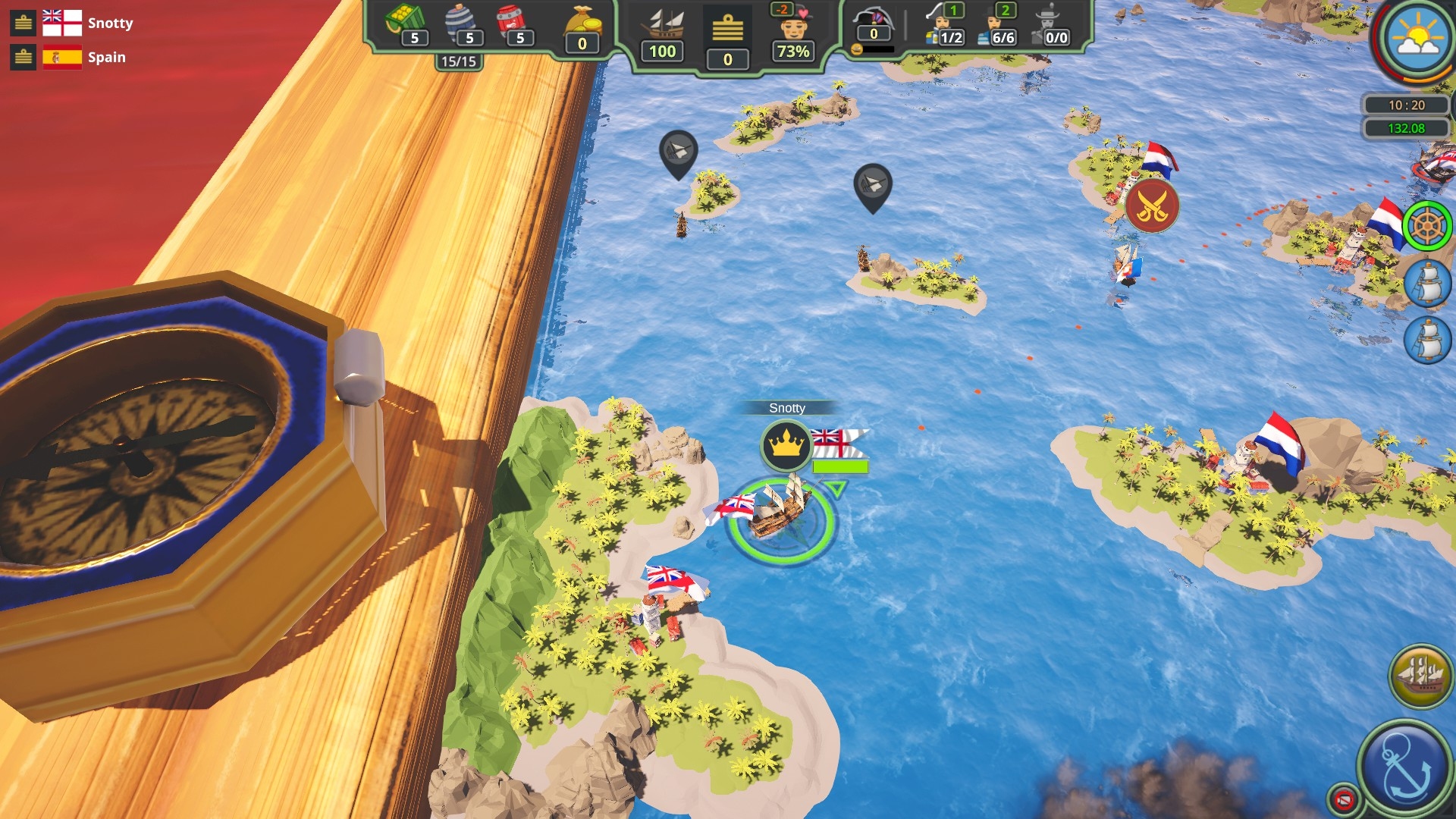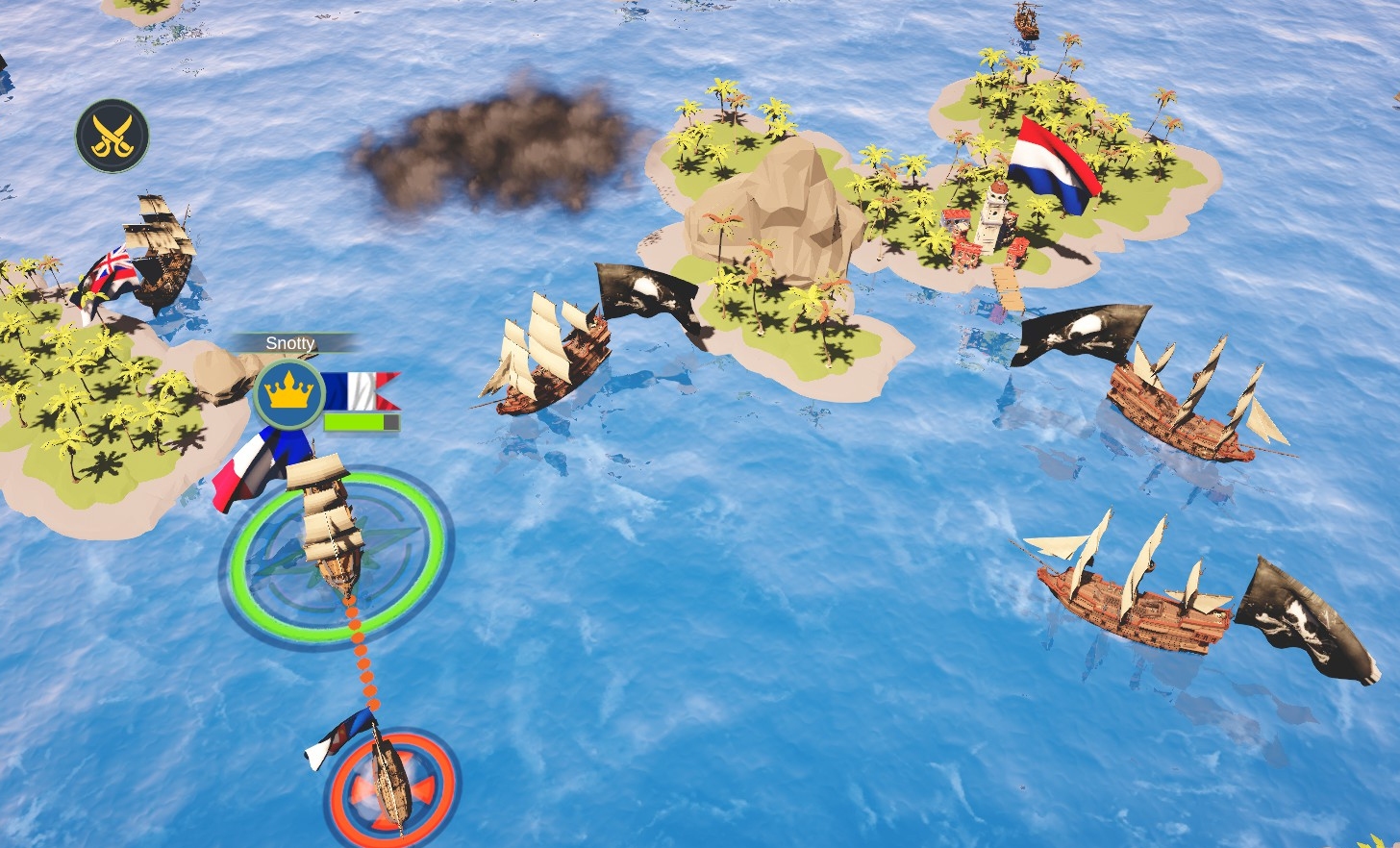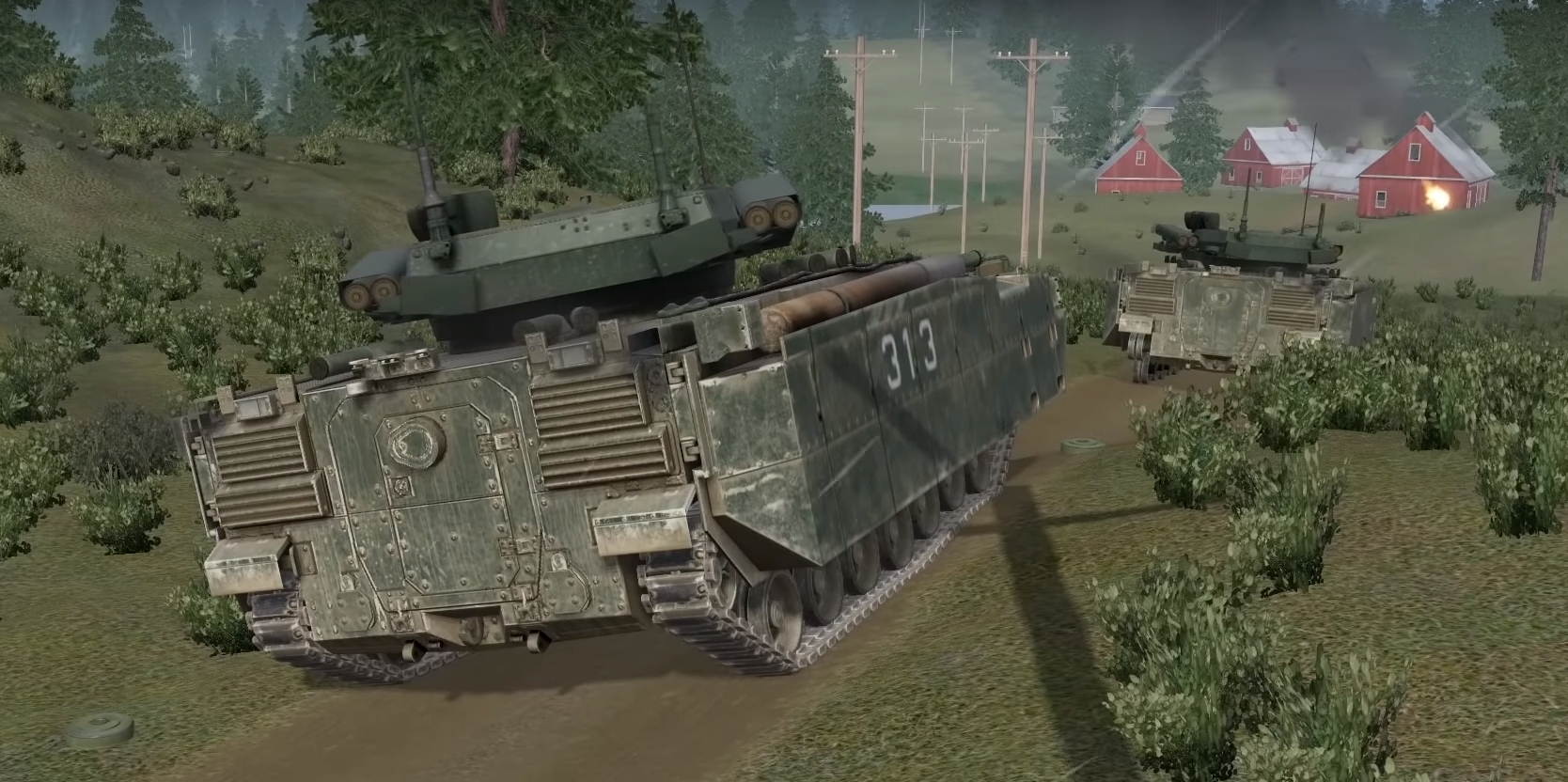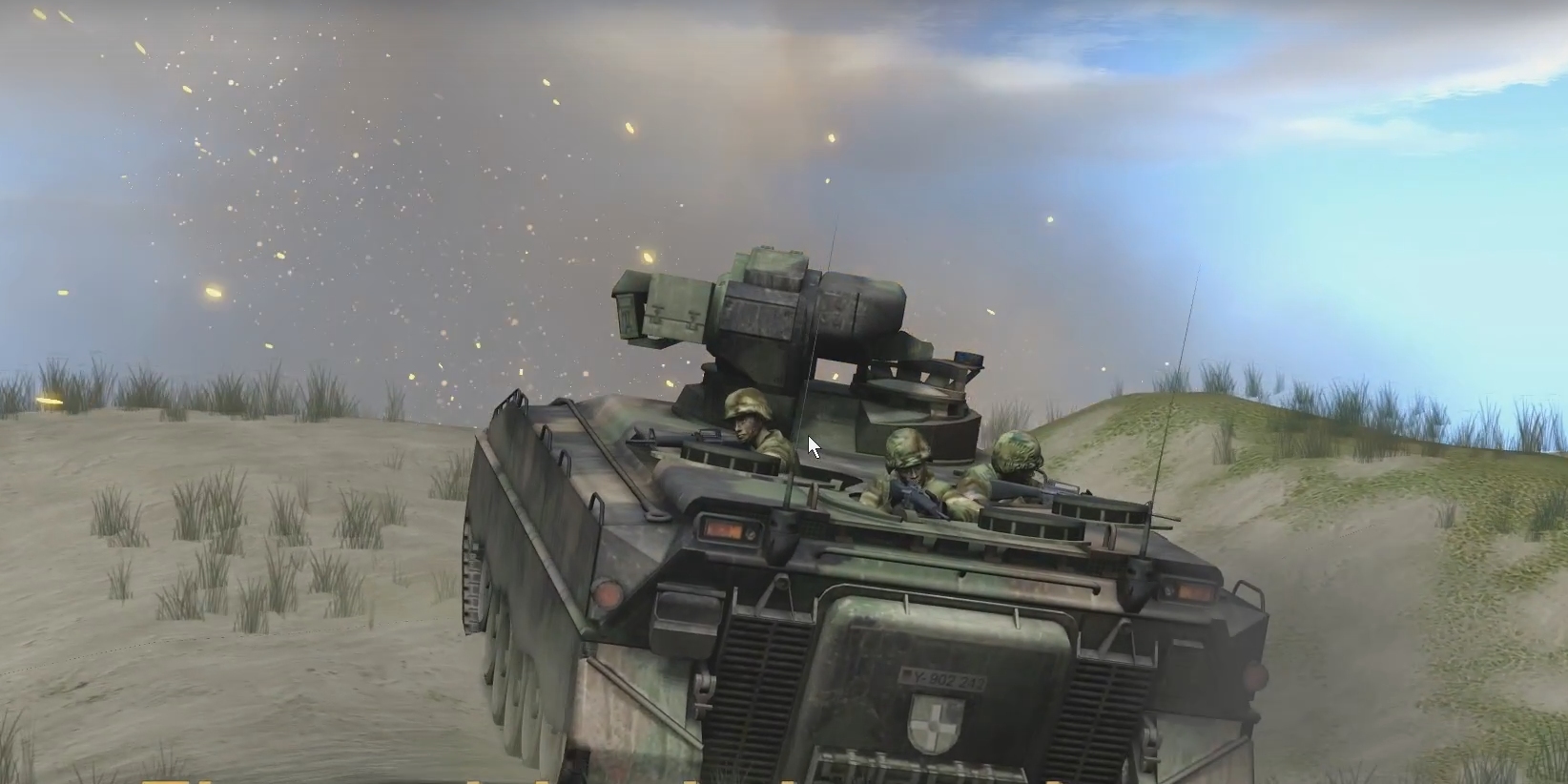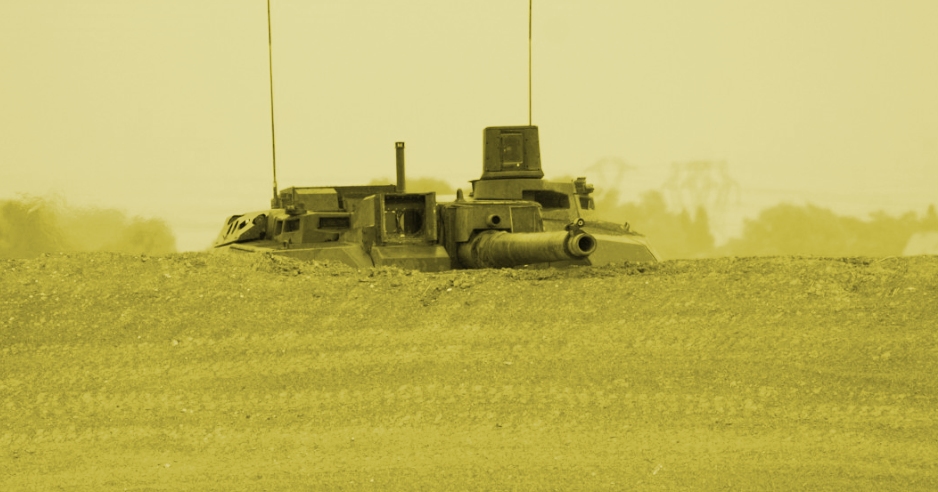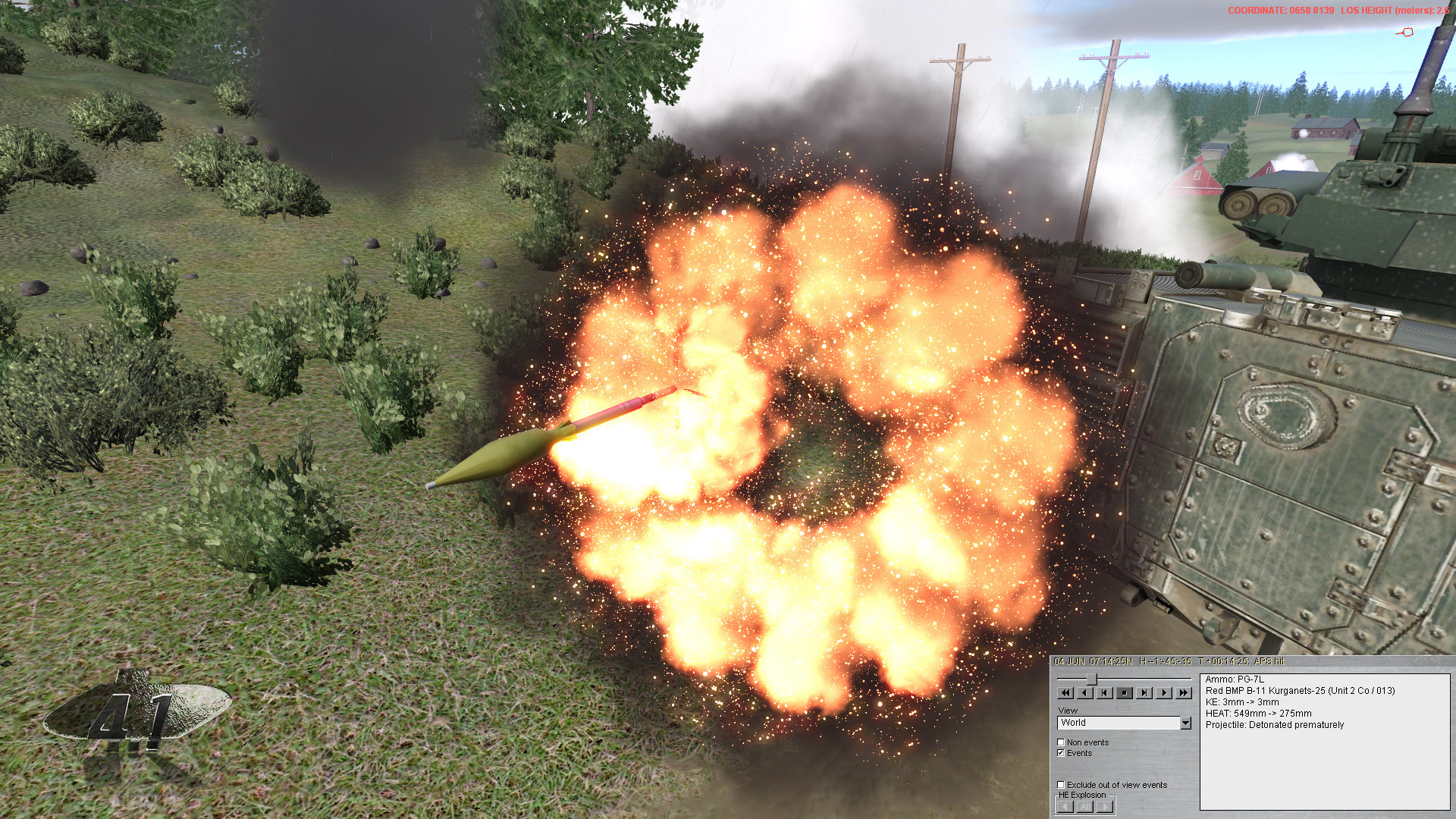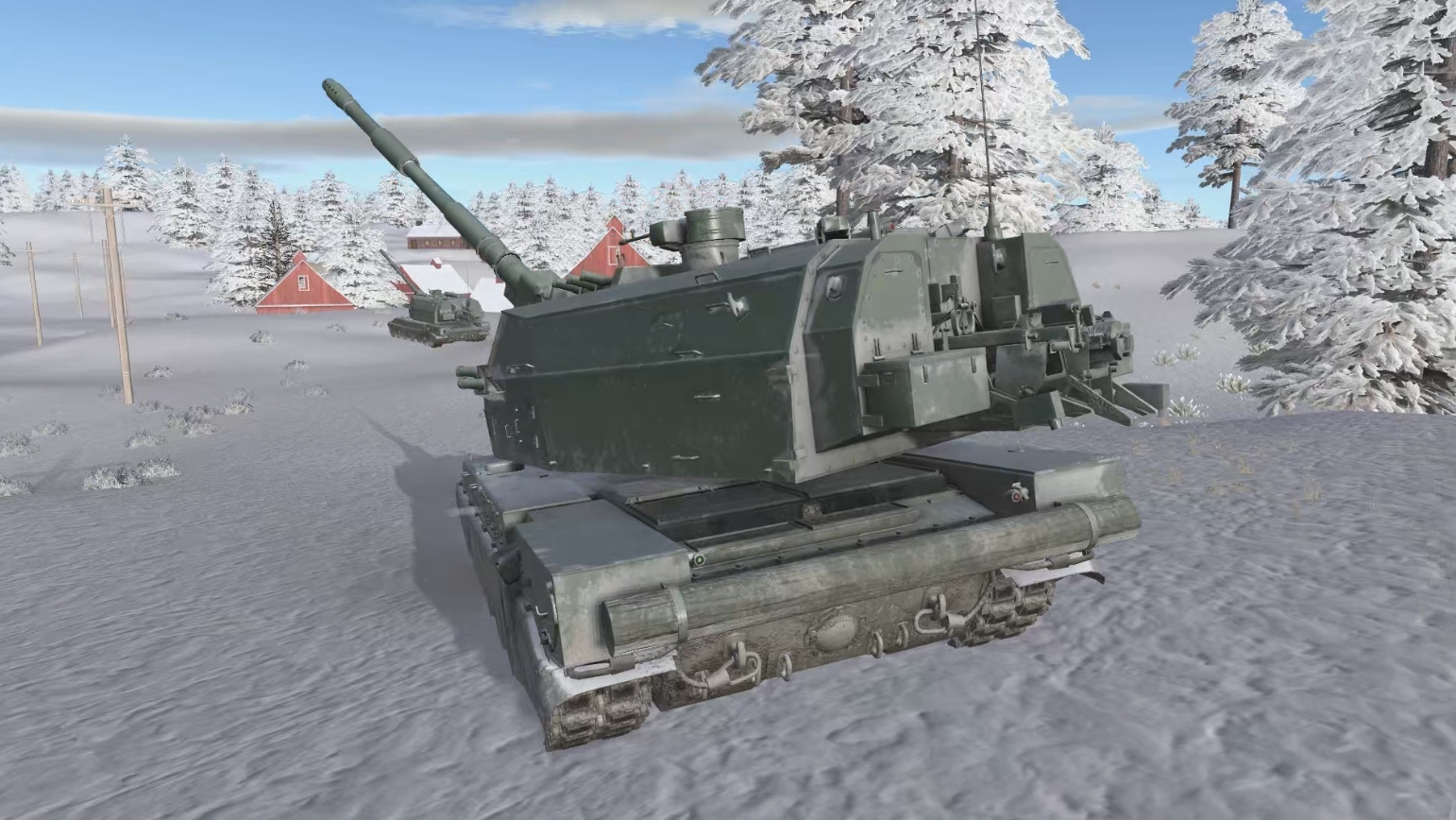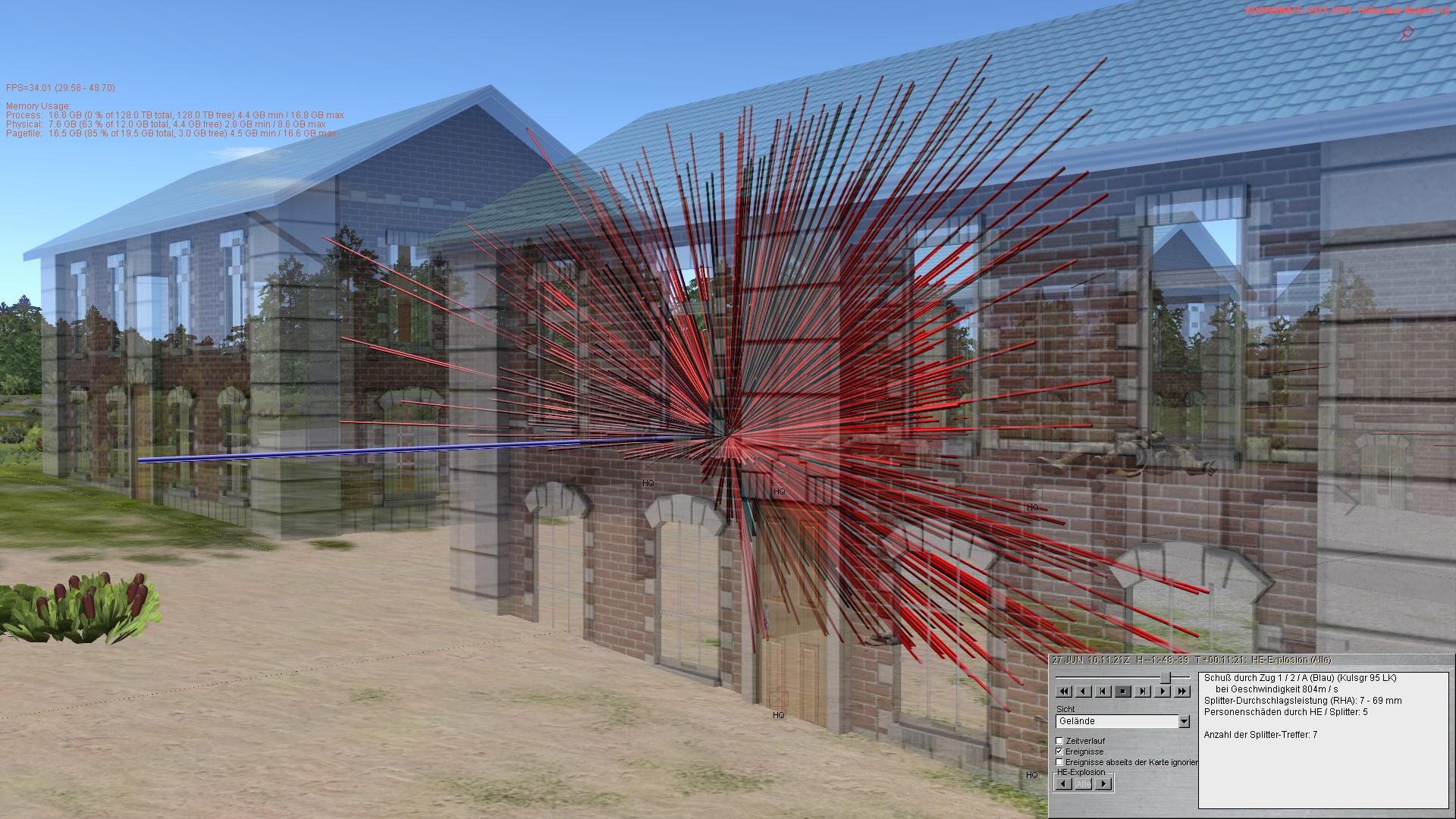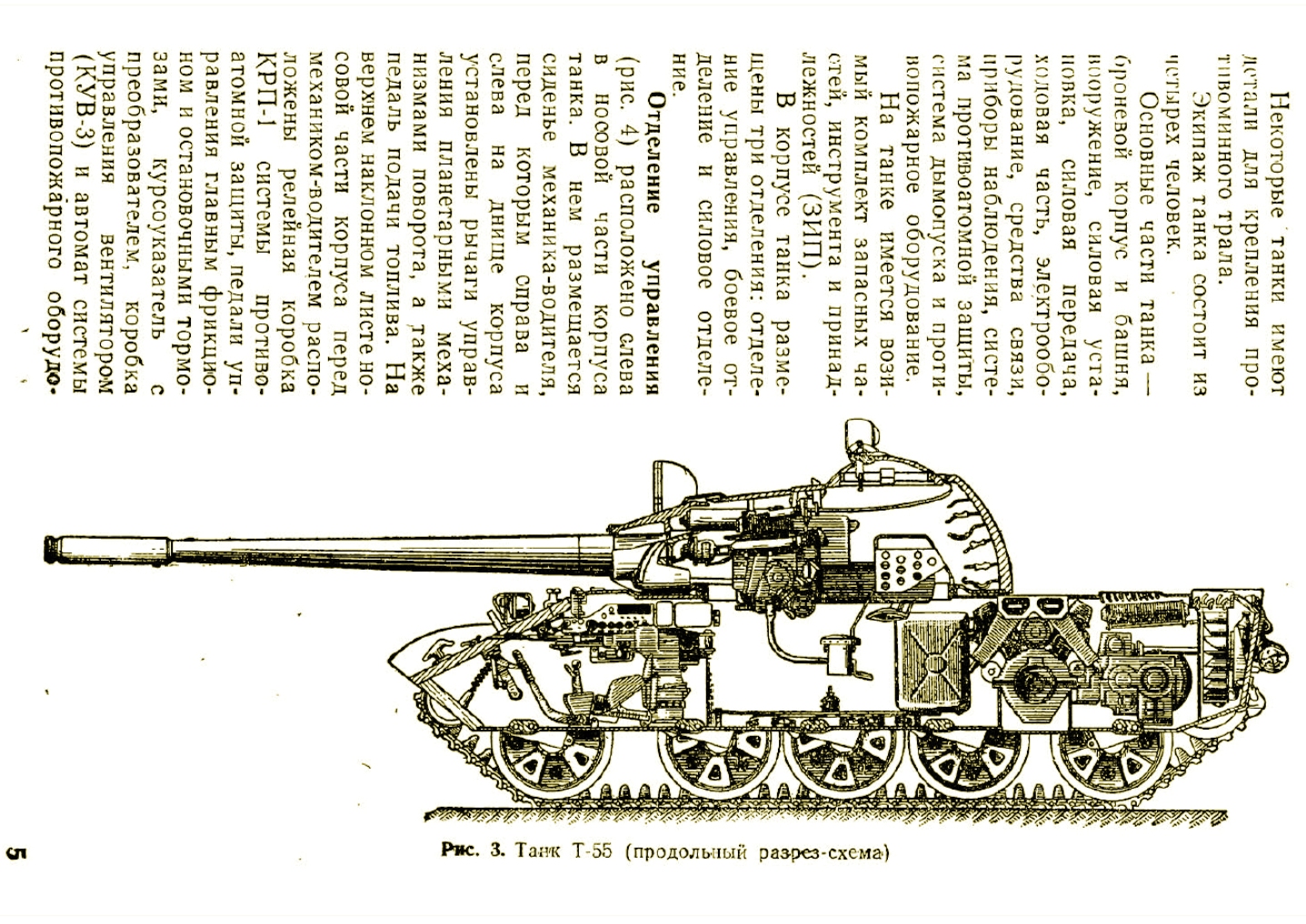The Flare Path: Invisible Hulls
HMS previewed. Steel Beasts 4.1 discussed
There was a nasty moment early on in my relationship with HMS when I thought me and Johan Nagel's latest weren't going to get on. In my first hour with the beta of this highly original turnless Hornblower-em-up I experienced five game-curtailing mutinies. Even on the lowest difficulty setting I couldn't make progress. Baffled disbelief was fast becoming sulky defeatism when the doubloon finally dropped. An email exchange with the designer and a second look at the tutorial and suddenly I was out of the doldrums and surging ahead.
Small changes to that tutorial prompted by my experience should mean your first sixty minutes with the due-on-July-12th HMS aren't dominated by frustration. Unlike me you should realise very early on that the hammock is far more important than the rum barrel or the galley stove when it comes to keeping sailors chipper. Keep your crew up all night tending sails, manning cannons, scrubbing decks or doing any of the other myriad duties an 18th Century warship generates, and their mood will sour faster than sun-warmed milk. Grasp this simple, logical fact and HMS should grow on you the way weed grows on an unsheathed frigate hull.
Pacy and taut, HMS is no historical simulation. Although the events and dilemmas that come thick and fast regularly bring to mind Hornblower, Bolitho, and Aubrey novels, the 'Caribbean' charts you crisscross are complete fantasies and the speed of actions like repairs and fort-building massively accelerated. Your aim is to climb to the top of a greasy career pole faster than an AI-controlled captain of an enemy nation. You gain promotion points by completing a succession of randomly-generated Admiralty and ship-related tasks, and through opportunistic privateering and port raids. Failures in any these areas haemorrhage PPs as quickly as successes garner them.
Admiralty missions take various forms - interceptions, escort details, port visits, fort construction expeditions... - all of which require relatively time-consuming voyages on the chart screen. Ship tasks - maintenance, cleaning, punishments, men overboard, gun drills etc. - are set in motion with single mouseclicks in the cutaway ship view and are usually done and dusted in under a minute assuming you have the requisite manpower available. An ingenious system of flags makes keeping track of in-progress and outstanding jobs easy.
If the competing pressures of time-limited chores and missions weren't sufficient mental stimulation, Nagel also packs the decision space with a host of less clear-cut distractions. Your vessel needs to be kept supplied with food, rum, and gunpowder. Crew morale must be monitored and bolstered, combat and accident casualties healed or replaced, officer training attended to. Boredom has about as much chance of surfacing during an HMS session as a wayward cannonball had of surfacing during the Battle of Trafalgar.
The intensity - the myriad competing concerns – come close to overwhelming at the start. Until I got my sea legs - until I realised that it was madness to try to execute every Admiralty order - I remained rooted to the foot of the six-rung career ladder. Once I learned to pick and choose directives and indulge in a little privateering when opportunities arose, my fortunes steadily improved.
Last night I made commodore for the first time and was rewarded with a new ship. Larger and better-armed, HMS Unnameable (Sadly there doesn't seem to be a way to christen craft or pick and choose paintjobs and figureheads) has sufficient room for marines, musket-armed redcoats who assist in engagements and permit certain actions like port capturing, raids, and fort building. Not long after this pleasing development I had the equally gratifying experience of seeing one of my officers, carefully trained over several hours of play, gain his first command, the ship appearing as a commandable RTS-style unit on the chart screen. Significant progression-linked changes like these bode well for the long game.
Combat is one area where the colourful HMS feels a tad insipid. When two hostile ships meet on the chart, a simple dice duel is triggered. Tactical input basically boils down to “How many cannons do you want to fire?” (Each cannon adds +1 to your roll). The choice is complicated by personnel and gunpowder availability, and the results can include interesting situations like mutual maulings, but many of the factors that influenced Age of Sail scraps are ignored. In a game dominated by warfare, unengaging engagements would be a major issue. Because HMS battles are brief interludes in far more colourful peaceful passages of play, their simplicity is, I would argue, no great handicap.
For every minute you spend trading iron spheres you probably spend thirty studying the storm and wreck dotted chart, purchasing provisions and pressganging sailor in ports, and working to keep your ship happy and efficient. Is it worth antagonizing the currently neutral Dutch by seizing another one of their merchants (When sufficiently riled the Netherlanders unleash The Flying Dutchman, a fearsome first-rate ship of the line)? Should you forego a flogging so that your ship is sure to reach a rendezvous in time? Is morale sufficiently high to withstand some nocturnal repairs prior to a brush with a pirate tub - a pirate tub that is hopefully still suffering the ill-effects of a clash with a Spanish warship (At times AI ships attack each other)? In HMS a captain's bicorn hat invariably encloses a busy cranium.
In early prototypes, the player's ship and crew were grubby and gloomy. The switch to a 3D Playmobil aesthetic wasn't universally popular - not in these parts anyway - but over the past couple of days I've warmed to the bright colours. The day-night cycles, details like circling sharks, and some nicely written and performed vocal cues, contribute to atmosphere not obvious from the screenshots. The way some of the cues are delivered is pure Ioan Gruffudd and all the better for it. Unfortunately, Every Single Soldier couldn't stretch to nation-specific utterances (Spanish and French cues may come later) or a period soundtrack rich in hornpipes and shanties.
While HMS definitely isn't the gritty weevil-sprinkled captain sim we brainstormed back in March 2017, it channels Hornblower better than anything else I'm aware of, is rammed with tough, interesting choices, and has the kind of natural momentum seldom seen in Flare Path fare. By mid-July I hope to have made Admiral of the Fleet at least once, so should be well-placed to proffer a helpful Wot I Think.
* * *
If eSim made nutty chocolate bars rather than rigorous contemporary AFV sims, they'd be preparing a new “NOW EVEN KNOBBLIER!” wrapper design round about now. In July players of Steel Beasts Pro Personal Edition willing to stump up for the 4.1 Upgrade will finally get the combat-complicating hillocks, ditches, craters, banks, bumps, and baulks they've been waiting for for donkey's years. The sim's terrain mesh is set to go from 'goal net' to 'Aran jumper' overnight. Interested in the implications of the resolution increase and the story behind the delay, I sought out one of Simulatia's most candid devs, Nils Hinrichsen. A conversation that starts with frank admissions ends with thought-provoking predictions and reflections on the risks of modelling modern war machines too truthfully.
RPS: Hi-res terrain has taken much longer than anticipated. Why?
Nils: Bad planning, and I bear the sole responsibility for it. The first variant we had in 2016 did what it was supposed to do, as demonstrated in our 2017 video "DTED is dead". We were running maybe half a year behind schedule which forced us to miss the release window, and in retrospect that was a blessing.
That first iteration would have meant giving up a lot of flexibility as far as content creation was concerned. You'd have had a fixed map that couldn't be edited at all, once it was made ready for scenario design. Somehow the need to adapt a map to the requirements of the scenario file was a critical requirement that we missed spelling out explicitly in the design document, probably because it was so second nature to "old hands" in the team that we thought that the new programmers would somehow magically "know" it.
Of course, he failed to read our minds. And for a good while the engine didn't perform well enough for our testers to properly test it, and by the time that everything worked well enough one of our military customers immediately pointed out the problem during a presentation; not the most glorious day in our history.
Initially we thought that the ability to edit the map could be handled with the introduction of so-called "delta maps" that would just store the cosmetic changes you made from the underlying "base map", and indeed that's a concept that we're using today. But there were more complications because the original Steel Beasts was even more flexible and we had introduced features with version 2.5 that increased that flexibility (and with it, the complexity) even more, and all those special cases needed to be handled. Only in the second half of 2016 did we begin to understand the true gravity of the situation we were in.
At the same time version 4.0 had already incorporated a lot of the changes to the render engine needed for the new terrain, so 4.0 was a release that sorta-kinda worked, but with significant losses in framerate with which nobody could be happy. So 2017 and 2018 were largely devoted to clambering out of the hole that we had dug for ourselves. What a magnificent hole that was!
With 4.0 we knew that the framerate was bleeding from a thousand paper cuts. Knowing that you need to heal paper cuts isn't difficult. Healing the individual paper cut isn't difficult. But handling a thousand, you run into scaling issues. That's why it took three more years.
RPS: Tactically speaking, what's the impact of the resolution change?
Nils: We're at the beginning of an entirely new experience. We haven't implemented everything that we want to do with this yet. But we now have the technological basis for it.
Real-time terrain deformation allows us to crater the terrain, even if we can't do this for everything that goes boom yet. Right now it's limited to IEDs which were our first test case, more application cases will follow in subsequent updates.
We can have engineer vehicles dig vehicle emplacements in real-time (and faster); real-time is too slow for quality entertainment, so we added some optional speed-up functions. But of course, engineers can do more with earth movers and dozer shields than just create vehicle emplacements - again, something that we will expand upon in future updates.
Procedural modification of the terrain allows the building of road ramps for over- and underpasses. The same concept could be added to automatically dig trenches parallel to road embankments. It's now finally possible to level roads going across a mountain slope.
But to get back to your original question - tests that some of our customers have conducted have shown two things. In the right terrain, engagements become either more one-sided, or more inconclusive. Competent players can now use small variations in the terrain a lot more to their advantage. At the same time you get hit more often in the turret area, which tends to make vehicles more survivable than what we've become accustomed to in twenty years of Steel Beasts usage. So all this is definitely more in line with real-life observations (Held, Manfred: Warhead hit distribution on main battle tanks in the Gulf War. Journal of Battlefield Technology 3 (2000)) as well as experiences from live exercises. And engagement ranges go down. In an extreme case, I tested the same terrain with both a 10m grid and our new sub-meter grid, and the average engagement range shifted from about 1250m to little more than 550 meters while ammunition consumption was cut in half. Game-play wise this probably spells "more tension" especially in player-to-player duel situation. Targets are visible for shorter durations, the use of artillery might become more important.
RPS: I understand "improved AI" is one of the central planks of 4.1. What form do the improvements take?
Nils: In the past our computer-controlled vehicles couldn't pass parked cars on the side of a road, they couldn't handle water bodies well, if you shot a vehicle on a two-lane bridge, following units couldn't bypass it on the other lane, giving a movement coordinate for infantry made them all converge on the same point rather than walking parallel to each other. Units fell into wadis. Infantry mounting and dismounting trucks in urban terrain was a disaster. Heck, all movement of infantry in cities was a disaster. You lost half of your men moving down one city block, due to corners and edges where they got stuck like zombies. These issues are largely gone. But there's still a lot more to do and the hi-res terrain with its host of "micro-obstacles" brings new pathfinding challenges.
RPS: I know the focus of 4.1 is not primarily new playable vehicles, but as there are some, would you introduce them?
Nils: The most interesting additions, I think, are the new Russian vehicles, simply because they are functionally a radical departure from traditional Soviet design concepts. For the first time Russian designs have made the protection of the crew the priority. Especially the integration of active protection systems like "Afganit" gives players of western tank models entirely different tactical challenges. They are all listed under the "Prototype" category in Steel Beasts. While Russia originally attempted to build them in significant numbers, the policy now seems to be to treat them more as concept vehicles for the time-being and modernize the legacy fleets (e.g. T-72B3, T-90MS) instead; a classic example for this (which we'll include in 4.1) would be the BTR-82A.
There's also a lot of utility vehicles that we added for the Dutch army, the ATTV Vector (which is more of a fun kart), the Mercedes G 300 CDi, the WLS and YAD supply trucks, and of course the Fennek family with its plethora of variants - carrying Stinger missiles, mortar troops, Spike missile teams, as reconnaissance and artillery observer vehicles - think of a heavy Humvee. None of these vehicles are particularly glamorous but if you're serious about simulating real life operations you can't ignore them. Finally, we added the CROWS II/Protector remote weapon station which can be put on a number of vehicles including the Kodiak armored engineer vehicle.
BMP B-11 Kurganets-25
A heavily protected infantry fighting vehicle with 30mm autocannon and AT-14 anti-tank missile launcher. Note the thick add-on armor, and the fan-like launchers for the "Afganit" active protection system. The turret is remotely operated and therefore unmanned. Crew protection can be concentrated on the vehicle hull.
BTR B-10 Kurganets-25
This armored personnel carrier shares the hull with the B-11 but comes without the heavy add-on armor, and has a smaller turret with only a 14.5mm heavy MG. Here the Afganit elements are mounted at the bottom of the turret.
T-14 Armata
This is a new MBT concept with a three-man crew, all located in the hull, with a remotely operated turret. At this point, that's the only concept with which the protection level of the crew can be increased without excessive growth of the vehicle mass. On top of the turret is another remotely operated weapon station with a smaller machine gun. Also visible is the sensor mast for meteorological data as well as laser detection to trigger the "softkill" system to fire smoke grenades in the direction of the laser.
K-17 Bumerang IFV
This one shares the turret with the B-11, but mounts it on a wheeled chassis. It is intended as a replacement for the aging BTR-80 fleet. It is somewhat comparable with the US Stryker vehicle, or the German Boxer with 30mm Lance turret which will be acquired by Australia in the coming years.
Typhoon-K
This mine-resistant vehicle has seen usage in Syria as a protected troop transport vehicle. In Steel Beasts it can be fitted with a remote weapon station. Thus equipped it's a good choice for a light convoy protection role.
2S35 Koalitsiya
The most modern howitzer in the Russian arsenal, caliber 152mm. It can execute fire missions relatively quickly, with a range of up to 32 kilometres.
BMP T-15 Armata
Shares the turret with K-17 Bumerang and B-11 Kurganets-25, and the hull with the T-14 MBT. It probably offers even more protection than the Kurganets IFV.
RPS: Do the new After-Action Review fragment diagrams reflect changes in your ballistics and damage models?
Nils: Absolutely! For the first time in Steel Beasts high explosives and fragmentation effects have a solid footing in the underlying engineering models. There's still more to do but we now have a realistic distribution of fragment masses, velocities, their spatial distribution, and more subjective parameter tweaking is thus reduced to a minimum.
Needless to say, simulating 5000+ fragments in a real-time application is a bit of a technological challenge.
RPS: Assuming you're happy to switch into soothsayer mode for a moment... In the next 10-20 years, which changes in AFV design/weaponry will, in your opinion, have the biggest impact on armoured warfare and, hence, Steel Beasts Pro PE?
Nils: I'm no better at predicting the future than anyone else. Which means, I'm really bad at it. Like everybody else. In descending order of confidence:
1. Winter is coming.
2. Multicopter drones change everything.
When I attended military academy we had assembly areas where one would prepare operations, and if you did your job right you had a good chance of remaining undetected from aerial reconnaissance. When you drove into a covert observation post and battle position you could expect to remain undetected until the first exchange of hostile fire. These assumptions are no longer valid. Solutions to the threat of pervasive aerial surveillance are yet to be found. Test results suggest that the best response to drones are counter-drones in a hunting role. The sound of a drone is the harbinger of the artillery strike to follow minutes later. In July 2014 near the town Zelenopillya a three-minute long artillery strike destroyed about 60% of an entire mechanized battalion. That's not to say that we're witnessing the end times of armored warfare. But it will change tactics substantially.
Active protection systems on the other hand are not necessarily a game changer, although they raise the challenge substantially.
3. AI on the battlefield
This is clearly speculative territory. I think that people massively overestimate the capabilities of artificial intelligence. If image recognition can be duped into thinking dogs are cars it is my firm belief that we shouldn't trust robots with lethal force, especially not autonomously, and while we're at it, with the capacity for rapid self-replication. ;)
But someone will probably be callous enough to give it a try. Probably a country with a poor human rights record, a large industrial base with a strong AI research capacity. Maybe somewhere near central Asia.
Oooh. My crystal ball has gone dark.
RPS: The Oleg Tishchenko case* has, doubtless, encouraged many sim studios to review processes and remind/warn staff. Has it had any repercussions at eSim?
*Recently found guilty and sentenced to a year in prison, Oleg, who has already spent a year in custody, is now back in Russia.
Nils: I cannot comment on this specific case, or that of the Bohemia Interactive developers that were interned in Greece a few years ago. But it's clear that we're operating in an area where you can't afford to be careless with the law. eSim Games has always worked on the basis of open sources, and what our military customers voluntarily shared with us. I constantly beg our customers to NOT tell us their secrets because knowing them would rob us of a lot of flexibility and freedom to work the way we do.
Everybody is better off working on the basis of "educated guesses" even if that means that sometimes your model is off. It may be somewhat surprising to hear me say it, but realism is not a worthy development goal in and of itself. Everything that we do is subordinate to the overarching goal of delivering good training value (and, where it doesn't stand in the way), good entertainment as well.
RPS: Thank you for your time.
* * *


